|
APRIL 2008���
�
29th April 2008 - News release
spheramine - retinal cell therapy for Parkinson's Disease
It has been claimed that a novel cell therapy
using retinal pigment epithelial (RPE) cells called Spheramine can improve
the symptoms of people with Parkinson�s disease. The cellular product,
called� Spheramine, consists of retinal pigment epithelial (RPE)
cells attached attached to tiny gelatin bead microcarriers implanted in
the brain. The microcarriers are necessary for the cells to survive in the
brain.
For more information go to
Spheramine.
�RPE cells, despite being in the eye,
also produce L-dopa, the precursor of dopamine whose deficiency usually
causes
Parkinson's
Disease. The implanted cells serve as a new potential source of L-dopa to
enhance dopamine production.
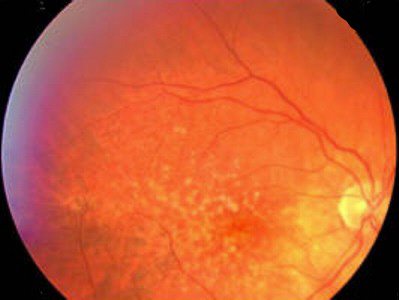 A pilot study was initiated that followed 6
patients with moderate to advanced Parkinson's Disease to investigate the
safety, tolerability, and efficacy of the Spheramine implantation. They
found no Spheramine-related serious adverse events. The researchers
reported a 44% reduction in symptoms, and a 23% improvement in quality of
life. Results from the pilot study have prompted the initiation of a
larger clinical.
For more information go to
the A pilot study was initiated that followed 6
patients with moderate to advanced Parkinson's Disease to investigate the
safety, tolerability, and efficacy of the Spheramine implantation. They
found no Spheramine-related serious adverse events. The researchers
reported a 44% reduction in symptoms, and a 23% improvement in quality of
life. Results from the pilot study have prompted the initiation of a
larger clinical.
For more information go to
the
News release.
The method does not account for the fact that it is insufficient dopamine formation
rather than a lack of dopamine producing cells that is known to
cause Parkinson's Disease.�
�
������������������������������������������������������������������������������������������������������������������������������������������������
��� 26th April 2008 - New research
sleep problems in
Parkinson's Disease
Movement Disorders [2008] 23 (1) : 35-41 (Verbaan
D, van Rooden SM, Visser M, Marinus J, van Hilten JJ.)�Complete abstract
Researchers evaluated nighttime sleep problems and daytime sleepiness in
people with Parkinson's disease. Over 400 people with Parkinson's Disease
were compared to controls. Compared to controls, a significantly greater
proportion
of people with Parkinson's Disease had excessive daytime sleepiness,
excessive nighttime sleep problems, or used sleep medication.
 People with
Parkinson's Disease were no different from other regarding falling asleep.
Women with Parkinson's Disease experienced more nighttime sleep problems
than men. Depressive symptoms were the greatest cause of differences
between people with Parkinson's Disease and others. Nighttime sleep
problems were related to dopamine-agonist and L-dopa dose. Daytime
Sleepiness was increased with age, dopamine-agonist dose, and the severity
of Parkinson's Disease. Nighttime sleep problems and daytime sleepiness
occur frequently in Parkinson's Disease, with excessive daytime sleepiness
being reported more commonly than nighttime sleep problems. People with
Parkinson's Disease were no different from other regarding falling asleep.
Women with Parkinson's Disease experienced more nighttime sleep problems
than men. Depressive symptoms were the greatest cause of differences
between people with Parkinson's Disease and others. Nighttime sleep
problems were related to dopamine-agonist and L-dopa dose. Daytime
Sleepiness was increased with age, dopamine-agonist dose, and the severity
of Parkinson's Disease. Nighttime sleep problems and daytime sleepiness
occur frequently in Parkinson's Disease, with excessive daytime sleepiness
being reported more commonly than nighttime sleep problems.
��������������������������������������������������������������������������������������������������������������������������������������������������
����������������������������������������������������������������������������������������������������������������������������������������������������������������������������� 24th April 2008 - New research
Anti-Oxidant Therapy fails Again in
Parkinson's Disease
The anti-oxidant mitoquinone (MitoQ) failed
to show any benefit in Parkinson's disease. Mitoquinone, a drug that is a
highly potent derivative of coenzyme Q10, was completely ineffective in a
clinical trial. The drug combines ubiquinone, the anti-oxidant portion of
the coenzyme Q10 molecule, with a lipophilic triphenylphosphonium cation.
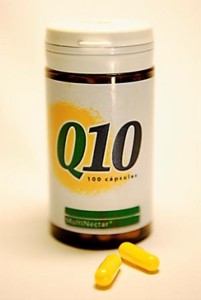 The
resulting agent is a thousand times more potent than coenzyme Q10 in
protecting cells from oxidative damage. Yet Parkinson's Disease patients
taking mitoquinone experienced worse side effects and greater
deterioration than patients taking a placebo. The side effects experienced
included nausea, which affected 85% of patients. Vomiting and diarrhea
occurred in 52% and 26% of patients respectively. The researchers said
that anti-oxidants can no longer be considered a practical treatment
approach. Idiopathic Parkinson's Disease has long been known to be due to
insufficient dopamine rather than oxidative damage.
For more information go to
the
Complete article. The
resulting agent is a thousand times more potent than coenzyme Q10 in
protecting cells from oxidative damage. Yet Parkinson's Disease patients
taking mitoquinone experienced worse side effects and greater
deterioration than patients taking a placebo. The side effects experienced
included nausea, which affected 85% of patients. Vomiting and diarrhea
occurred in 52% and 26% of patients respectively. The researchers said
that anti-oxidants can no longer be considered a practical treatment
approach. Idiopathic Parkinson's Disease has long been known to be due to
insufficient dopamine rather than oxidative damage.
For more information go to
the
Complete article.
Last year, a
clinical study using coenzyme Q10 also found no evidence of efficacy in
Parkinson's disease.
For more information go to
the
Complete article.
�
23rd April 2008 - New review
FXTAS - A NEW FORM OF
PARKINSONISM
Fragile X syndrome is a genetic disorder
caused by mutation of the FMR1 gene on the X chromosome. Fragile X
Syndrome is the most common form of hereditary mental retardation.
Carriers of premutation (CGG) expansions of the fragile X gene are
generally thought to be spared most of the problems associated with the
full mutation. However, a recently discovered neurological disorder -
FXTAS (Fragile X-associated Tremor/Ataxia Syndrome) - involving
progressively severe tremor and difficulty with walking and balance,
appears to specifically affect some older pre-mutation carriers. They are
often oblivious to the fact that they are carriers and that they have
symptoms of FXTAS rather than Parkinson's Disease, because the symptoms
can coincide. For more information go to
FXTAS.
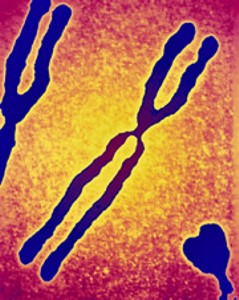 The
disorder affects at least a third of male carriers over 50 years of age.
Older men were much more likely to develop symptoms. Especially prone are
those men who have grandchildren with Fragile X Syndrome, because that
makes it more likely that they are a carrier of the mutation. Women are
hardly affected. Tremor is usually the first symptom to appear, most
typically at around 60 years of age, but often earlier. Tremor is usually
followed by ataxia (incoordination), then proneness to falling. Males were
more agitated, aggressive, depressed, apathetic, disinhibited, and
irritable. There is also impairment of intellectual functioning, that is
eventually on a scale similar to that seen in Alzheimer's Disease. In
those female carriers without the core features (tremor, and difficulty
with walking and balance), there were more complaints of chronic muscle
pain, and history of tremor than is normal. The
disorder affects at least a third of male carriers over 50 years of age.
Older men were much more likely to develop symptoms. Especially prone are
those men who have grandchildren with Fragile X Syndrome, because that
makes it more likely that they are a carrier of the mutation. Women are
hardly affected. Tremor is usually the first symptom to appear, most
typically at around 60 years of age, but often earlier. Tremor is usually
followed by ataxia (incoordination), then proneness to falling. Males were
more agitated, aggressive, depressed, apathetic, disinhibited, and
irritable. There is also impairment of intellectual functioning, that is
eventually on a scale similar to that seen in Alzheimer's Disease. In
those female carriers without the core features (tremor, and difficulty
with walking and balance), there were more complaints of chronic muscle
pain, and history of tremor than is normal.
�
21st April 2008 - New research
which is better - l-dopa or dopamine
agonists ?
Cochrane Database of Systematic Reviews
[2008], Issue 2 (Stowe RL, Ives NJ, Clarke C, van Hilten J, Ferreira J,
Hawker RJ, Shah L, Wheatley K, Gray R.)
�Complete abstract
Dopamine agonists are being increasingly used as a primary treatment for
Parkinson's disease, but there remains uncertainty about their clinical
effectiveness relative to L-dopa. This study aimed to quantify more
reliably the
benefits
and risks of dopamine agonists compared to placebo or L-dopa in early
Parkinson's disease.
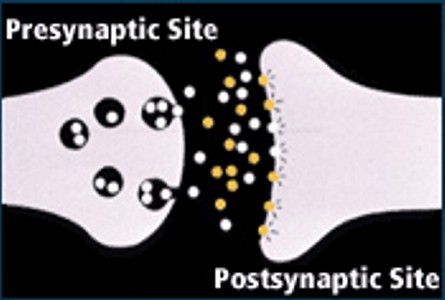 The researchers analysed all relevant clinical
trials. Patients taking dopamine agonists were less likely develop
dyskinesia, dystonia and motor fluctuations. However, various "non-motor"
side effects were all increased when taking dopamine agonists.� These
included oedema, somnolence, constipation, dizziness, hallucinations and
nausea. People taking dopamine agonists were also much more likely to
discontinue treatment due to adverse events. Symptom control of
Parkinson's Disease was better with L-dopa than with dopamine agonists. The researchers analysed all relevant clinical
trials. Patients taking dopamine agonists were less likely develop
dyskinesia, dystonia and motor fluctuations. However, various "non-motor"
side effects were all increased when taking dopamine agonists.� These
included oedema, somnolence, constipation, dizziness, hallucinations and
nausea. People taking dopamine agonists were also much more likely to
discontinue treatment due to adverse events. Symptom control of
Parkinson's Disease was better with L-dopa than with dopamine agonists.
�
20th April 2008 - New research
Non-motor symptoms as the first symptoms
of parkinson's disease
Movement Disorders [2008] 23 (1) : 101-106
(O'Sullivan SS, Williams DR, Gallagher DA, Massey LA, Silveira-Moriyama L,
Lees AJ.)
Complete abstract
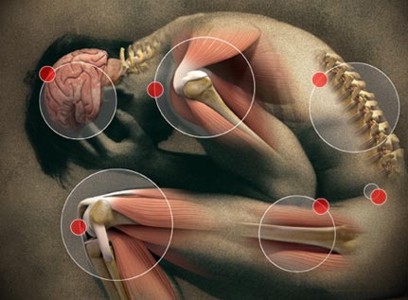 Non-motor symptoms (NMS), those that did not concern physical movement,
are a well recognized component of the clinical picture in some patients.
However, the prevalence of non-motor symptoms as the initial symptoms in
proven cases of Parkinson's Disease was unknown. Over 400 people with
Parkinson's Disease were assessed for their initial symptoms. Over 20% of
people with Parkinson's Disease were found to have initial symptoms that
were non-motor symptoms instead. The
most frequent symptoms that initiated Parkinson's Disease in those people
were pain (15%),
urinary dysfunction (3.9%), anxiety or
depression (2.5%). Non-motor symptoms (NMS), those that did not concern physical movement,
are a well recognized component of the clinical picture in some patients.
However, the prevalence of non-motor symptoms as the initial symptoms in
proven cases of Parkinson's Disease was unknown. Over 400 people with
Parkinson's Disease were assessed for their initial symptoms. Over 20% of
people with Parkinson's Disease were found to have initial symptoms that
were non-motor symptoms instead. The
most frequent symptoms that initiated Parkinson's Disease in those people
were pain (15%),
urinary dysfunction (3.9%), anxiety or
depression (2.5%).
When the initial symptoms were non-motor symptoms,
there was a delayed diagnosis of Parkinson's Disease, most probably
because the non-motor symptoms can occur because of other medical
disorders. These people were more likely to be misdiagnosed and were more
commonly referred to orthopaedic surgeons or rheumatologists rather than
neurologists. The initial symptoms being non-motor symptoms does not
affect the subsequent response to Parkinson's Disease drugs, but is
associated with shorter disease duration.
�
19th April 2008 - News release
altropane - a new diagnostic drug for
Parkinson's disease
Alseres Pharmaceuticals are beginning Phase
III clinical trials on Altropane, which is an investigational, diagnostic
drug developed by Alseres to enable doctors to distinguish Parkinsonian
Syndromes from non-Parkinsonian Syndromes in patients with tremor. There
is presently a 20%-30% rate of misdiagnosis in Parkinson's Disease, that
has resulted in many people presently being treated for
Parkinson's Disease that don't even have it. The presence of
tremor
is the main cause of misdiagnosis.
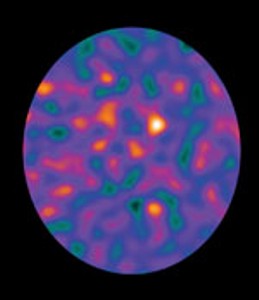 Altropane is a
molecular imaging agent that specifically binds to the dopamine transporter (DAT) protein found on
the surface of dopamine-producing
neurons, making it visible during� "SPECT" imaging. Since most forms
of Parkinsonian Syndromes result in the decreased activity of dopamine-producing cells, it would be
expected that these patients also have fewer DATs (dopamine transporter
proteins) than do patients without Parkinsonian Syndromes. Patients could
be distinguished because Non-Parkinsonian patients would have more
Altropane-binding visible in the SPECT image, while Parkinsonian patients
would have less.
For more information go to
the
Complete article. Altropane is a
molecular imaging agent that specifically binds to the dopamine transporter (DAT) protein found on
the surface of dopamine-producing
neurons, making it visible during� "SPECT" imaging. Since most forms
of Parkinsonian Syndromes result in the decreased activity of dopamine-producing cells, it would be
expected that these patients also have fewer DATs (dopamine transporter
proteins) than do patients without Parkinsonian Syndromes. Patients could
be distinguished because Non-Parkinsonian patients would have more
Altropane-binding visible in the SPECT image, while Parkinsonian patients
would have less.
For more information go to
the
Complete article.
It is not explained
why an additional diagnostic tool, such as a drug, is actually needed to
be used with SPECT imaging, when SPECT imaging is already more than 98%
reliable in diagnosing Parkinson's Disease. The medical disorders
distinguished by Altropane are no different from those that� SPECT
imaging already distinguishes. For more information got to
Functional brain imaging.
�
18th April 2008 - New research
genetic Parkinson's disease goes back
2,500 years
Annals of Neurology [2008] Apr 15 [Epub ahead
of print] (Ross OA, Wu YR, Lee MC, Funayama M, Chen ML, Soto AI, Mata IF,
Lee-Chen GJ, Chen CM, Tang M, Zhao Y, Hattori N, Farrer MJ, Tan EK, Wu
RM.)
Complete abstract
Neurology [2008] 70 (16 Pt 2) : 1456-1460
(Haugarvoll K, Rademakers R, Kachergus JM, Nuytemans K, Ross OA, Gibson
JM, Tan EK, Gaig C, Tolosa E, Goldwurm S, Guidi M, Riboldazzi G, Brown L,
Walter U, Benecke R, Berg D, Gasser T, Theuns J, Pals P, Cras P, De Deyn
PP, Engelborghs S, Pickut B, Uitti RJ, Foroud T, Nichols WC, Hagenah J,
Klein C, Samii A, Zabetian CP, Bonifati V, Van Broeckhoven C, Farrer MJ,
Wszolek ZK.)
Complete abstract
There
are a number of genetic causes of Parkinson's Disease. A large study
amongst Han Chinese showed that one of these genetic mutations, LRRK2 (leucine-rich
repeat kinase 2) nearly doubled the risk of Parkinson's Disease,
and that
the genetic mutation goes back around 2,500 years.
 The study proved two
points - that genetic Parkinson's Disease increases the likelihood of
Parkinson's Disease rather than inevitably causes it, and that Parkinson's
Disease goes back thousands of years. Another study showed that people
with a form of that genetic Parkinson's Disease (LRRK2) appeared to be no
different from people with idiopathic Parkinson's Disease, in age of onset
and clinical features. So people would not readily know whether or not
they had genetic Parkinson's Disease, or that the development of their
symptoms had been genetically more likely since they were born. The study proved two
points - that genetic Parkinson's Disease increases the likelihood of
Parkinson's Disease rather than inevitably causes it, and that Parkinson's
Disease goes back thousands of years. Another study showed that people
with a form of that genetic Parkinson's Disease (LRRK2) appeared to be no
different from people with idiopathic Parkinson's Disease, in age of onset
and clinical features. So people would not readily know whether or not
they had genetic Parkinson's Disease, or that the development of their
symptoms had been genetically more likely since they were born.
�
17th April 2008 - New research
SINEMET v STALEVO
Sinemet consists
of L-dopa and Carbidopa (a dopa
decarboxylase inhibitor that� helps to prevent the metabolism of
L-dopa before it reaches the dopaminergic neurons).
Stalevo consists
of L-dopa, Carbidopa and
Entacopone (Comtan). Entacapone (Comtan) inhibits the COMT enzyme,
thereby prolonging the effects of L-dopa, and so has been used to
complement L-dopa.�At present, the Stalevo combination is approved by
the FDA for use in patients who suffer a wearing off of the effect of the
Sinemet combination. Sinemet and Stalevo were compared for their therapeutic
effects. The change in activity of daily living scores was a bit better with
Stalevo.
Physician-rated improvements were 25% higher with Stalevo. Clinical Global
Impression scores were marginally better with Stalevo, as were daily living
and motor subscales of the Unified Parkinson's Disease Rating Scale.
Overall adverse events were more common with the Stalevo combination
than with the Sinemet combination, but serious adverse events were
similar for the two products. The difference was primarily in nausea (26.6%
versus 13.5%) and diarrhea (8.7% versus 2.8%).
 Motor complications tended to be less common with the Stalevo combination. Dyskinesia occurred in 5.3% of
Stalevo patients and 7.4% of Sinemet patients.
The study author claimed that the findings provide the basis for Novartis, who market the
Stalevo combination in the U.S.A., to apply for use of Stalevo for early
Parkinson's disease as well. This study was published as an abstract and
presented at a conference.
For more information go to
the
Complete article. Motor complications tended to be less common with the Stalevo combination. Dyskinesia occurred in 5.3% of
Stalevo patients and 7.4% of Sinemet patients.
The study author claimed that the findings provide the basis for Novartis, who market the
Stalevo combination in the U.S.A., to apply for use of Stalevo for early
Parkinson's disease as well. This study was published as an abstract and
presented at a conference.
For more information go to
the
Complete article.
�
����������������������������������������������������������������������������������������������������������������������������������������������������
15th April 2008 - New research
using inosine to increase urate� to
reduce Parkinson's disease
American Journal of Epidemiology [2008] 167 (7)
: 831-838 (Gao X, Chen H, Choi HK, Curhan G, Schwarzschild MA, Ascherio A.)
Complete abstract
End-of-dose wearing off was seen in 13.9%
versus 20%, respectively (P=0.09). The Michael J. Fox Foundation announced
a $5.6 million award for a Phase 2 clinical trial to investigate the
potential of inosine - a naturally occurring chemical that gives rise to
urate in the body - to slow or stop the progression of Parkinson's
disease. For more information go to the
Complete article.
Urate is a natural metabolite and antioxidant in humans. Inosine is widely
available to consumers in dietary supplement form.
Inosine is able to
forum urate, which is why it is being
proposed
to increase urate levels. For more information go to
Urate formation.
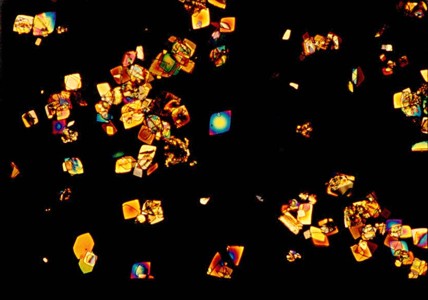 A recent large study confirmed that
higher
dietary urate was associated with a lower risk of Parkinson's Disease
Disease. The authors consequently suggest that dietary changes expected to
increase plasma urate level may contribute to a lower risk of Parkinson's
Disease. However, no rationale has been provided by the authors that would
explain the link. The evidence to date surrounding inosine and Parkinson's
Disease does not prove a cause-effect relationship.� Also, elevated
urate levels are known to cause health risks, only some of which have been
characterized to date. A recent large study confirmed that
higher
dietary urate was associated with a lower risk of Parkinson's Disease
Disease. The authors consequently suggest that dietary changes expected to
increase plasma urate level may contribute to a lower risk of Parkinson's
Disease. However, no rationale has been provided by the authors that would
explain the link. The evidence to date surrounding inosine and Parkinson's
Disease does not prove a cause-effect relationship.� Also, elevated
urate levels are known to cause health risks, only some of which have been
characterized to date.
�
14th April 2008 - New book
Parkinson's Disease and Other Movement
Disorders
Mark Edwards, Niall Quinn
and Kailash Bhatia
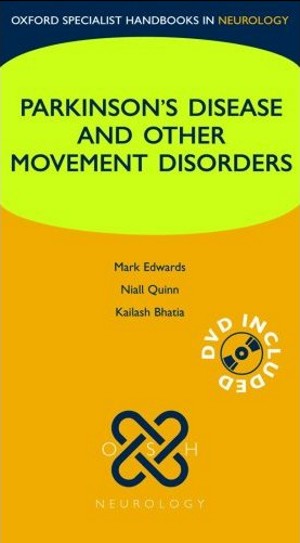 Publisher's
description : Movement disorders are a group of neurological conditions
that are characterised by problems with movement. Parkinson's disease is
the most common of these conditions. Its treatment is complex, but
effective, and there have been many recent exciting developments in the
field. Other movement disorders are less common and extremely diverse, so
it is difficult for practitioners to become proficient in diagnosing and
treating them all. This book will help neurologists and other clinicians
in the recognition and treatment of this group of disorders. Written in a
concise, easy-to-use handbook format, it should appeal to a
multidisciplinary audience. The text is accompanied by a DVD.
Click here for more details�� Publisher's
description : Movement disorders are a group of neurological conditions
that are characterised by problems with movement. Parkinson's disease is
the most common of these conditions. Its treatment is complex, but
effective, and there have been many recent exciting developments in the
field. Other movement disorders are less common and extremely diverse, so
it is difficult for practitioners to become proficient in diagnosing and
treating them all. This book will help neurologists and other clinicians
in the recognition and treatment of this group of disorders. Written in a
concise, easy-to-use handbook format, it should appeal to a
multidisciplinary audience. The text is accompanied by a DVD.
Click here for more details��
�
12th April 2008 - News report
NEW PARKINSON'S DISEASE DRUG FAILS IN
CLINICAL TRIALS �
Eisai have been clinically testing Perampanel
(E2007), which is an orally administered, highly selective non-competitive
AMPA-type glutamate receptor antagonist, for use in Parkinson's disease,
Neuropathic pain, Epilepsy, Multiple sclerosis and Migraine. The intended
use for Perampanel
was as an add-on
therapy to L-dopa in patients with late-stage Parkinson's Disease.
However, Perampanel failed in clinical trials
to have any effect in Parkinson's Disease. Eisai have consequently decided
to terminate further clinical trials for Parkinson's Disease, and its
possible future use, but will continue its testing with other medical
disorders.
For more information go
to
the
News release.
 This is the
latest of several new approaches to Parkinson's Disease that has been
found when properly tested to have no significant effect. Given that
Parkinson's Disease is largely due to reduced dopamine, the assessment of
Perampanel was lacking a scientific rationale from the outset, because
even in theory it was known to have no effect on the formation of
dopamine. This is the
latest of several new approaches to Parkinson's Disease that has been
found when properly tested to have no significant effect. Given that
Parkinson's Disease is largely due to reduced dopamine, the assessment of
Perampanel was lacking a scientific rationale from the outset, because
even in theory it was known to have no effect on the formation of
dopamine.
�
10th April 2008 - New research
DEMENTIA AND SURVIVAL IN PARKINSON'S DISEASE
�����������������������������������
Neurology [2008] 70 (13) : 1017-1022 (Buter
TC, van den Hout A, Matthews FE, Larsen JP, Brayne C, Aarsland D.)
Complete abstract
The risk of dementia in Parkinson disease is high, with important clinical
consequences for people with Parkinson's Disease. However, the absolute
risk of dementia and how it affects survival in Parkinson's Disease were
not known. Researchers assessed the prevalence of Parkinson's Disease with
dementia as people age. Over 60% of people with Parkinson's Disease were
eventually found to also have dementia. The cumulative incidence of
dementia was found to steadily
increase with age and duration of Parkinson's Disease. So for those that
live until 90 years of age the likelihood of dementia increases to
80% to 90%. Women live with Parkinson's
Disease
longer
than men and spend more years with
dementia.
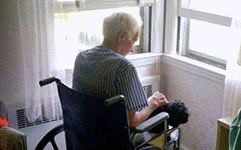 At the age of 70, a man with Parkinson's Disease but no dementia
has a life expectancy of 8 years, of which 5 years would be expected to be
dementia free and 3 years would be expected to be with dementia. Although
dementia was found to be common in Parkinson's Disease, and appear almost
inevitable in the oldest of sufferers, no comparison was made with the
general population to see if people without Parkinson's Disease were
almost as likely to develop dementia. Parkinson's Disease is biochemically
distinct from dementia. So there is no inevitable reason why they should
coincide. At the age of 70, a man with Parkinson's Disease but no dementia
has a life expectancy of 8 years, of which 5 years would be expected to be
dementia free and 3 years would be expected to be with dementia. Although
dementia was found to be common in Parkinson's Disease, and appear almost
inevitable in the oldest of sufferers, no comparison was made with the
general population to see if people without Parkinson's Disease were
almost as likely to develop dementia. Parkinson's Disease is biochemically
distinct from dementia. So there is no inevitable reason why they should
coincide.
�
9th April 2008 - New research
TREATING PARKINSON'S
DISEASE WITH TROPHIC FACTORS���������������������������������������������������
Neurotherapeutics [2008] 5 (2) : 270-280
(Peterson AL, Nutt JG.)
Complete abstract
Trophic factors are proteins that support and protect cells. A number of
them have been reported to act on dopaminergic neurons, the cells whose
reduced activity causes Parkinson's Disease. Consequently, it has been
claimed that they are potential therapeutic candidates for Parkinson's
Disease. They all protect dopaminergic neurons if given prior to, or with,
selective neurotoxins. Fewer trophic factors, primarily GDNF (glial-derived
neurotrophic factor) and neurturin (NRTN), have been shown to restore
function in damaged dopaminergic neurons
after
the acute effects of neurotoxins have
subsided. However, a major barrier to clinical use has been delivery.
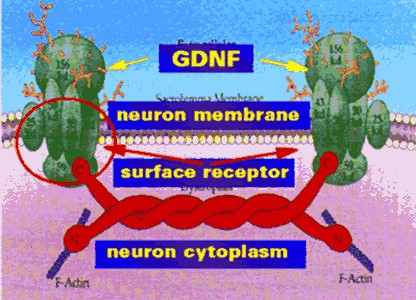 GDNF
delivered by intracerebroventricular
injection was ineffective, probably because GDNF did not reach the target.
Intraputaminal infusion was also ineffective, probably because of limited
distribution within the putamen, which is where it was aimed. A clinical
trial with gene therapy for NRTN is underway in an attempt to overcome
these problems with targeting and
distribution. So far, clinical trials have focused on restoration of
function. Protection - slowing or halting progression and functional
decline - has been suggested to be a more likely effect of trophic agents.
Beneficial use for such compounds in patients with Parkinson's Disease
remains unproven. GDNF
delivered by intracerebroventricular
injection was ineffective, probably because GDNF did not reach the target.
Intraputaminal infusion was also ineffective, probably because of limited
distribution within the putamen, which is where it was aimed. A clinical
trial with gene therapy for NRTN is underway in an attempt to overcome
these problems with targeting and
distribution. So far, clinical trials have focused on restoration of
function. Protection - slowing or halting progression and functional
decline - has been suggested to be a more likely effect of trophic agents.
Beneficial use for such compounds in patients with Parkinson's Disease
remains unproven.
�
7th April 2008 - New research
TRANSPLANTED CELLS STILL DEVELOP PARKINSON'S
DISEASE���������������������������������������������������
Nature Medicine [2008] Apr 7 [Epub ahead
of print] (Jia-Yi Li1, Elisabet Englund, Janice L Holton, Denis Soulet,
Peter Hagell, Andrew J Lees, Tammaryn Lashley, Niall P Quinn, Stig
Rehncrona, Anders Bj�rklund, H�kan Widner, Tamas Revesz, Olle Lindvall,
Patrik Brundin)
Complete abstract
Nature Medicine [2008] Apr 7 [Epub ahead
of print] (Jeffrey H Kordower, Yaping Chu, Robert A Hauser, Thomas B
Freeman, C Warren Olanow)
Complete abstract
The dopaminergic neurons are the cells whose deficient activity causes
Parkinson's Disease. It had been theorised that new cells transplanted�
in to the brain would increase the formation of dopamine because those new
cells would not have developed
Parkinson's Disease.
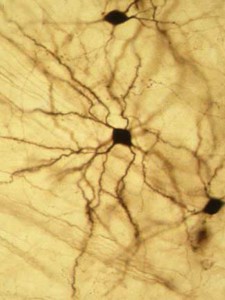 However, two new studies have shown that transplanted
cells will cease to
function
normally, and will still develop
changes that are characteristic of Parkinson's Disease. In
one study, two
subjects who had transplanted
dopaminergic neurons developed alpha-synuclein positive Lewy bodies, which
are signs of Parkinson's Disease. This shows that implanted cells can
develop the same biochemical fault that occurs in Parkinson's Disease. In
another study, another individual who'd had new cells, was found to have
developed in those cells the Parkinson's Disease symptom of Lewy body�like
inclusions that stained positively for alpha-synuclein and ubiquitin. The
study confirms that Parkinson's Disease is a biochemical state that can
affect any cells - both those that were already there, and those that are
placed there. However, two new studies have shown that transplanted
cells will cease to
function
normally, and will still develop
changes that are characteristic of Parkinson's Disease. In
one study, two
subjects who had transplanted
dopaminergic neurons developed alpha-synuclein positive Lewy bodies, which
are signs of Parkinson's Disease. This shows that implanted cells can
develop the same biochemical fault that occurs in Parkinson's Disease. In
another study, another individual who'd had new cells, was found to have
developed in those cells the Parkinson's Disease symptom of Lewy body�like
inclusions that stained positively for alpha-synuclein and ubiquitin. The
study confirms that Parkinson's Disease is a biochemical state that can
affect any cells - both those that were already there, and those that are
placed there.
�
6th April 2008 - New research
CHOLESTEROL LOWERS THE RISK OF PARKINSON'S
DISEASE���������������������������������������������������
Movement Disorders [2008] Mar 31 [Epub ahead
of print] (Huang X, Abbott RD, Petrovitch H, Mailman RB, Ross GW.)
Complete abstract
Low density lipoproteins transport cholesterol through the arteries. For
more information go to
Low density lipoproteins. Low-density lipoprotein cholesterol levels
are claimed to be inversely associated with Parkinson's Disease.
Basically, it was believed that the the more cholesterol somebody has, the
less likely they were to have Parkinson's Disease. To test this
hypothesis, the authors studied
over
3,000 men, whose LDL-Cholesterol levels had
been measured.
 These men were assessed for
nearly ten years for the development of Parkinson's Disease. The incidence
of Parkinson's Disease increased with decreasing LDL-Cholesterol in a
dose-dependent manner. So cholesterol actually made Parkinson's Disease
less likely. The association was only significant for men aged 71 to 75
years, but it did make a great difference to chances of getting
Parkinson's Disease. This prospective study supports the hypothesis that
low LDL-Cholesterol is associated with an increased risk of Parkinson's
Disease. The study does not explain why more cholesterol, something
usually assumed to be unhealthy, actually lowers the likelihood of
Parkinson's Disease. These men were assessed for
nearly ten years for the development of Parkinson's Disease. The incidence
of Parkinson's Disease increased with decreasing LDL-Cholesterol in a
dose-dependent manner. So cholesterol actually made Parkinson's Disease
less likely. The association was only significant for men aged 71 to 75
years, but it did make a great difference to chances of getting
Parkinson's Disease. This prospective study supports the hypothesis that
low LDL-Cholesterol is associated with an increased risk of Parkinson's
Disease. The study does not explain why more cholesterol, something
usually assumed to be unhealthy, actually lowers the likelihood of
Parkinson's Disease.
�
4th April 2008 - New research
THE EFFECT OF PARKINSON'S DISEASE ON CAREGIVERS������������������������������������������������
��������������������������������������������������������������������������������������������������������������������������������������������������������������������������
European Journal of Physical Rehabilitation Medicine [2008] 44 (2) : 39-45
(Lokk J.)
Complete abstract
The task of managing care for patients with Parkinson's disease often
falls upon a family member taking on the role as a caregiver. The aim of
this study was to evaluate the strain on caregivers of Parkinson's Disease
patients.� The mean age of caregivers was 68, with nearly two thirds
being female, probably because there are more men than women with
Parkinson's Disease to care for. The general health of caregivers was
regarded as satisfactory, independently of
how long the person they had been caring for
had Parkinson's Disease. However, caregivers still
suffered
a variety of problems due to being
caregivers.
 The following problems occurred in caregivers, with the
percentage of caregivers that experienced them : disease related stress
61%,� insufficient sleep 31% (often because of the disturbed sleep of
the person they were caring for), decreased mood 31%, daily problems with
tiredness and sleep disturbance 30%, hypertension 27%, muscle strain
headache and fatigue 17%, gastro-intestinal problems 14%. Most of these
were unrelated to the duration of the Parkinson's Disease of the person
they were caring for. Caregivers found motor dysfunction the most
difficult problem to deal with in those they cared for, with 58% of
caregivers citing this as the worst problem. More than half of the
caregivers experienced little or no understanding of their situation. The following problems occurred in caregivers, with the
percentage of caregivers that experienced them : disease related stress
61%,� insufficient sleep 31% (often because of the disturbed sleep of
the person they were caring for), decreased mood 31%, daily problems with
tiredness and sleep disturbance 30%, hypertension 27%, muscle strain
headache and fatigue 17%, gastro-intestinal problems 14%. Most of these
were unrelated to the duration of the Parkinson's Disease of the person
they were caring for. Caregivers found motor dysfunction the most
difficult problem to deal with in those they cared for, with 58% of
caregivers citing this as the worst problem. More than half of the
caregivers experienced little or no understanding of their situation.
�
2nd April 2008 - New research
THE EFFECT OF TAI CHI ON PARKINSON'S DISEASE
��������������������������������������������������������������������������������������������������������������������������������������������
Parkinsonism Related Disorders [2008] Mar 26;
[Epub ahead of print] (Lee MS, Lam P, Ernst E.)
Complete abstract
The after effect of exercise is reduced
muscle contraction, which is the
same aim as Parkinson's Disease drugs. For this reason, and to maintain
mobility, many people supplement their Parkinson's Disease treatment with
exercise. It has often been claimed that Tai Chi is a particularly good
form of exercise for this purpose. Tai Chi is a traditional
Chinese
martial art and form of exercise.
For more information go to
Tai Chi.
 The objective of this review was to assess
the effectiveness of Tai Chi as a treatment option for Parkinson's
Disease. All relevant studies in the medical literature were examined. Of
the seven studies included, one randomised clinical trial found Tai Chi to
be superior to conventional exercise for Parkinson's Disease, and the
prevention of falls. Another trial found no effects of Tai Chi on
locomotor ability compared with Qigong. The third failed to show any
effects of Tai Chi in Parkinson's Disease. The remaining studies were
either non-randomised or uncontrolled clinical trials. In conclusion, the
evidence is insufficient to suggest that Tai Chi is effective in
Parkinson's Disease. The objective of this review was to assess
the effectiveness of Tai Chi as a treatment option for Parkinson's
Disease. All relevant studies in the medical literature were examined. Of
the seven studies included, one randomised clinical trial found Tai Chi to
be superior to conventional exercise for Parkinson's Disease, and the
prevention of falls. Another trial found no effects of Tai Chi on
locomotor ability compared with Qigong. The third failed to show any
effects of Tai Chi in Parkinson's Disease. The remaining studies were
either non-randomised or uncontrolled clinical trials. In conclusion, the
evidence is insufficient to suggest that Tai Chi is effective in
Parkinson's Disease.
�
1st April 2008 - New research
FATIGUE IN PARKINSON'S DISEASE
Journal of the Neurological Sciences 2008 Mar
25; [Epub ahead of print] (Havlikova E, van Dijk JP, Rosenberger J,
Nagyova I, Middel B, Dubayova T, Gdovinova Z, Groothoff JW.)
Complete abstract
����������������������������������������������������������������������������������������������������������������������������������������������
Many patients with Parkinson's disease suffer
from non-motor symptoms such as sleep disturbances, excessive daytime
sleepiness and fatigue. The aim of this research was to find out whether
fatigue in Parkinson's Disease is caused by sleepiness and sleep problems,
or depression, and how that is related to a person's functional status.
Sleepiness
did not show significant association with fatigue in any aspect of
fatigue.
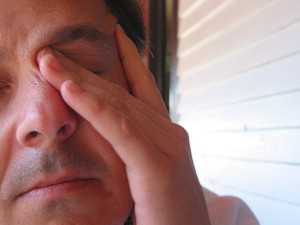 Neither did the quality of a person's sleep. It was depression
that was significantly associated with all aspects of fatigue, the
strongest being the relationship with general fatigue, then reduced
motivation, then mental fatigue, then physical fatigue, and finally with
reduced activity. The worsening of functional status was significantly
related most of all to reduced activity, then general fatigue, then
physical fatigue, and then mental fatigue. So it is primarily depression
that causes fatigue in Parkinson's Disease. Fatigue can in turn worsen
symptoms. Neither did the quality of a person's sleep. It was depression
that was significantly associated with all aspects of fatigue, the
strongest being the relationship with general fatigue, then reduced
motivation, then mental fatigue, then physical fatigue, and finally with
reduced activity. The worsening of functional status was significantly
related most of all to reduced activity, then general fatigue, then
physical fatigue, and then mental fatigue. So it is primarily depression
that causes fatigue in Parkinson's Disease. Fatigue can in turn worsen
symptoms.
�
�
|
.gif)
.gif)
 A pilot study was initiated that followed 6
patients with moderate to advanced Parkinson's Disease to investigate the
safety, tolerability, and efficacy of the Spheramine implantation. They
found no Spheramine-related serious adverse events. The researchers
reported a 44% reduction in symptoms, and a 23% improvement in quality of
life. Results from the pilot study have prompted the initiation of a
larger clinical.
For more information go to
the
A pilot study was initiated that followed 6
patients with moderate to advanced Parkinson's Disease to investigate the
safety, tolerability, and efficacy of the Spheramine implantation. They
found no Spheramine-related serious adverse events. The researchers
reported a 44% reduction in symptoms, and a 23% improvement in quality of
life. Results from the pilot study have prompted the initiation of a
larger clinical.
For more information go to
the
 People with
Parkinson's Disease were no different from other regarding falling asleep.
Women with Parkinson's Disease experienced more nighttime sleep problems
than men. Depressive symptoms were the greatest cause of differences
between people with Parkinson's Disease and others. Nighttime sleep
problems were related to dopamine-agonist and L-dopa dose. Daytime
Sleepiness was increased with age, dopamine-agonist dose, and the severity
of Parkinson's Disease. Nighttime sleep problems and daytime sleepiness
occur frequently in Parkinson's Disease, with excessive daytime sleepiness
being reported more commonly than nighttime sleep problems.
People with
Parkinson's Disease were no different from other regarding falling asleep.
Women with Parkinson's Disease experienced more nighttime sleep problems
than men. Depressive symptoms were the greatest cause of differences
between people with Parkinson's Disease and others. Nighttime sleep
problems were related to dopamine-agonist and L-dopa dose. Daytime
Sleepiness was increased with age, dopamine-agonist dose, and the severity
of Parkinson's Disease. Nighttime sleep problems and daytime sleepiness
occur frequently in Parkinson's Disease, with excessive daytime sleepiness
being reported more commonly than nighttime sleep problems.  The
resulting agent is a thousand times more potent than coenzyme Q10 in
protecting cells from oxidative damage. Yet Parkinson's Disease patients
taking mitoquinone experienced worse side effects and greater
deterioration than patients taking a placebo. The side effects experienced
included nausea, which affected 85% of patients. Vomiting and diarrhea
occurred in 52% and 26% of patients respectively. The researchers said
that anti-oxidants can no longer be considered a practical treatment
approach. Idiopathic Parkinson's Disease has long been known to be due to
insufficient dopamine rather than oxidative damage.
For more information go to
the
The
resulting agent is a thousand times more potent than coenzyme Q10 in
protecting cells from oxidative damage. Yet Parkinson's Disease patients
taking mitoquinone experienced worse side effects and greater
deterioration than patients taking a placebo. The side effects experienced
included nausea, which affected 85% of patients. Vomiting and diarrhea
occurred in 52% and 26% of patients respectively. The researchers said
that anti-oxidants can no longer be considered a practical treatment
approach. Idiopathic Parkinson's Disease has long been known to be due to
insufficient dopamine rather than oxidative damage.
For more information go to
the
 The
disorder affects at least a third of male carriers over 50 years of age.
Older men were much more likely to develop symptoms. Especially prone are
those men who have grandchildren with Fragile X Syndrome, because that
makes it more likely that they are a carrier of the mutation. Women are
hardly affected. Tremor is usually the first symptom to appear, most
typically at around 60 years of age, but often earlier. Tremor is usually
followed by ataxia (incoordination), then proneness to falling. Males were
more agitated, aggressive, depressed, apathetic, disinhibited, and
irritable. There is also impairment of intellectual functioning, that is
eventually on a scale similar to that seen in Alzheimer's Disease. In
those female carriers without the core features (tremor, and difficulty
with walking and balance), there were more complaints of chronic muscle
pain, and history of tremor than is normal.
The
disorder affects at least a third of male carriers over 50 years of age.
Older men were much more likely to develop symptoms. Especially prone are
those men who have grandchildren with Fragile X Syndrome, because that
makes it more likely that they are a carrier of the mutation. Women are
hardly affected. Tremor is usually the first symptom to appear, most
typically at around 60 years of age, but often earlier. Tremor is usually
followed by ataxia (incoordination), then proneness to falling. Males were
more agitated, aggressive, depressed, apathetic, disinhibited, and
irritable. There is also impairment of intellectual functioning, that is
eventually on a scale similar to that seen in Alzheimer's Disease. In
those female carriers without the core features (tremor, and difficulty
with walking and balance), there were more complaints of chronic muscle
pain, and history of tremor than is normal.  The researchers analysed all relevant clinical
trials. Patients taking dopamine agonists were less likely develop
dyskinesia, dystonia and motor fluctuations. However, various "non-motor"
side effects were all increased when taking dopamine agonists.� These
included oedema, somnolence, constipation, dizziness, hallucinations and
nausea. People taking dopamine agonists were also much more likely to
discontinue treatment due to adverse events. Symptom control of
Parkinson's Disease was better with L-dopa than with dopamine agonists.
The researchers analysed all relevant clinical
trials. Patients taking dopamine agonists were less likely develop
dyskinesia, dystonia and motor fluctuations. However, various "non-motor"
side effects were all increased when taking dopamine agonists.� These
included oedema, somnolence, constipation, dizziness, hallucinations and
nausea. People taking dopamine agonists were also much more likely to
discontinue treatment due to adverse events. Symptom control of
Parkinson's Disease was better with L-dopa than with dopamine agonists. Non-motor symptoms (NMS), those that did not concern physical movement,
are a well recognized component of the clinical picture in some patients.
However, the prevalence of non-motor symptoms as the initial symptoms in
proven cases of Parkinson's Disease was unknown. Over 400 people with
Parkinson's Disease were assessed for their initial symptoms. Over 20% of
people with Parkinson's Disease were found to have initial symptoms that
were non-motor symptoms instead. The
most frequent symptoms that initiated Parkinson's Disease in those people
were pain (15%),
urinary dysfunction (3.9%), anxiety or
depression (2.5%).
Non-motor symptoms (NMS), those that did not concern physical movement,
are a well recognized component of the clinical picture in some patients.
However, the prevalence of non-motor symptoms as the initial symptoms in
proven cases of Parkinson's Disease was unknown. Over 400 people with
Parkinson's Disease were assessed for their initial symptoms. Over 20% of
people with Parkinson's Disease were found to have initial symptoms that
were non-motor symptoms instead. The
most frequent symptoms that initiated Parkinson's Disease in those people
were pain (15%),
urinary dysfunction (3.9%), anxiety or
depression (2.5%).  Altropane is a
molecular imaging agent that specifically binds to the dopamine transporter (DAT) protein found on
the surface of dopamine-producing
neurons, making it visible during� "SPECT" imaging. Since most forms
of Parkinsonian Syndromes result in the decreased activity of dopamine-producing cells, it would be
expected that these patients also have fewer DATs (dopamine transporter
proteins) than do patients without Parkinsonian Syndromes. Patients could
be distinguished because Non-Parkinsonian patients would have more
Altropane-binding visible in the SPECT image, while Parkinsonian patients
would have less.
For more information go to
the
Altropane is a
molecular imaging agent that specifically binds to the dopamine transporter (DAT) protein found on
the surface of dopamine-producing
neurons, making it visible during� "SPECT" imaging. Since most forms
of Parkinsonian Syndromes result in the decreased activity of dopamine-producing cells, it would be
expected that these patients also have fewer DATs (dopamine transporter
proteins) than do patients without Parkinsonian Syndromes. Patients could
be distinguished because Non-Parkinsonian patients would have more
Altropane-binding visible in the SPECT image, while Parkinsonian patients
would have less.
For more information go to
the
 The study proved two
points - that genetic Parkinson's Disease increases the likelihood of
Parkinson's Disease rather than inevitably causes it, and that Parkinson's
Disease goes back thousands of years. Another study showed that people
with a form of that genetic Parkinson's Disease (LRRK2) appeared to be no
different from people with idiopathic Parkinson's Disease, in age of onset
and clinical features. So people would not readily know whether or not
they had genetic Parkinson's Disease, or that the development of their
symptoms had been genetically more likely since they were born.
The study proved two
points - that genetic Parkinson's Disease increases the likelihood of
Parkinson's Disease rather than inevitably causes it, and that Parkinson's
Disease goes back thousands of years. Another study showed that people
with a form of that genetic Parkinson's Disease (LRRK2) appeared to be no
different from people with idiopathic Parkinson's Disease, in age of onset
and clinical features. So people would not readily know whether or not
they had genetic Parkinson's Disease, or that the development of their
symptoms had been genetically more likely since they were born. Motor complications tended to be less common with the Stalevo combination. Dyskinesia occurred in 5.3% of
Stalevo patients and 7.4% of Sinemet patients.
The study author claimed that the findings provide the basis for Novartis, who market the
Stalevo combination in the U.S.A., to apply for use of Stalevo for early
Parkinson's disease as well. This study was published as an abstract and
presented at a conference.
For more information go to
the
Motor complications tended to be less common with the Stalevo combination. Dyskinesia occurred in 5.3% of
Stalevo patients and 7.4% of Sinemet patients.
The study author claimed that the findings provide the basis for Novartis, who market the
Stalevo combination in the U.S.A., to apply for use of Stalevo for early
Parkinson's disease as well. This study was published as an abstract and
presented at a conference.
For more information go to
the
 A recent large study confirmed that
higher
dietary urate was associated with a lower risk of Parkinson's Disease
Disease. The authors consequently suggest that dietary changes expected to
increase plasma urate level may contribute to a lower risk of Parkinson's
Disease. However, no rationale has been provided by the authors that would
explain the link. The evidence to date surrounding inosine and Parkinson's
Disease does not prove a cause-effect relationship.� Also, elevated
urate levels are known to cause health risks, only some of which have been
characterized to date.
A recent large study confirmed that
higher
dietary urate was associated with a lower risk of Parkinson's Disease
Disease. The authors consequently suggest that dietary changes expected to
increase plasma urate level may contribute to a lower risk of Parkinson's
Disease. However, no rationale has been provided by the authors that would
explain the link. The evidence to date surrounding inosine and Parkinson's
Disease does not prove a cause-effect relationship.� Also, elevated
urate levels are known to cause health risks, only some of which have been
characterized to date.
 Publisher's
description : Movement disorders are a group of neurological conditions
that are characterised by problems with movement. Parkinson's disease is
the most common of these conditions. Its treatment is complex, but
effective, and there have been many recent exciting developments in the
field. Other movement disorders are less common and extremely diverse, so
it is difficult for practitioners to become proficient in diagnosing and
treating them all. This book will help neurologists and other clinicians
in the recognition and treatment of this group of disorders. Written in a
concise, easy-to-use handbook format, it should appeal to a
multidisciplinary audience. The text is accompanied by a DVD.
Publisher's
description : Movement disorders are a group of neurological conditions
that are characterised by problems with movement. Parkinson's disease is
the most common of these conditions. Its treatment is complex, but
effective, and there have been many recent exciting developments in the
field. Other movement disorders are less common and extremely diverse, so
it is difficult for practitioners to become proficient in diagnosing and
treating them all. This book will help neurologists and other clinicians
in the recognition and treatment of this group of disorders. Written in a
concise, easy-to-use handbook format, it should appeal to a
multidisciplinary audience. The text is accompanied by a DVD.
 This is the
latest of several new approaches to Parkinson's Disease that has been
found when properly tested to have no significant effect. Given that
Parkinson's Disease is largely due to reduced dopamine, the assessment of
Perampanel was lacking a scientific rationale from the outset, because
even in theory it was known to have no effect on the formation of
dopamine.
This is the
latest of several new approaches to Parkinson's Disease that has been
found when properly tested to have no significant effect. Given that
Parkinson's Disease is largely due to reduced dopamine, the assessment of
Perampanel was lacking a scientific rationale from the outset, because
even in theory it was known to have no effect on the formation of
dopamine.
 At the age of 70, a man with Parkinson's Disease but no dementia
has a life expectancy of 8 years, of which 5 years would be expected to be
dementia free and 3 years would be expected to be with dementia. Although
dementia was found to be common in Parkinson's Disease, and appear almost
inevitable in the oldest of sufferers, no comparison was made with the
general population to see if people without Parkinson's Disease were
almost as likely to develop dementia. Parkinson's Disease is biochemically
distinct from dementia. So there is no inevitable reason why they should
coincide.
At the age of 70, a man with Parkinson's Disease but no dementia
has a life expectancy of 8 years, of which 5 years would be expected to be
dementia free and 3 years would be expected to be with dementia. Although
dementia was found to be common in Parkinson's Disease, and appear almost
inevitable in the oldest of sufferers, no comparison was made with the
general population to see if people without Parkinson's Disease were
almost as likely to develop dementia. Parkinson's Disease is biochemically
distinct from dementia. So there is no inevitable reason why they should
coincide.  GDNF
delivered by intracerebroventricular
injection was ineffective, probably because GDNF did not reach the target.
Intraputaminal infusion was also ineffective, probably because of limited
distribution within the putamen, which is where it was aimed. A clinical
trial with gene therapy for NRTN is underway in an attempt to overcome
these problems with targeting and
distribution. So far, clinical trials have focused on restoration of
function. Protection - slowing or halting progression and functional
decline - has been suggested to be a more likely effect of trophic agents.
Beneficial use for such compounds in patients with Parkinson's Disease
remains unproven.
GDNF
delivered by intracerebroventricular
injection was ineffective, probably because GDNF did not reach the target.
Intraputaminal infusion was also ineffective, probably because of limited
distribution within the putamen, which is where it was aimed. A clinical
trial with gene therapy for NRTN is underway in an attempt to overcome
these problems with targeting and
distribution. So far, clinical trials have focused on restoration of
function. Protection - slowing or halting progression and functional
decline - has been suggested to be a more likely effect of trophic agents.
Beneficial use for such compounds in patients with Parkinson's Disease
remains unproven. However, two new studies have shown that transplanted
cells will cease to
function
normally, and will still develop
changes that are characteristic of Parkinson's Disease. In
one study, two
subjects who had transplanted
dopaminergic neurons developed alpha-synuclein positive Lewy bodies, which
are signs of Parkinson's Disease. This shows that implanted cells can
develop the same biochemical fault that occurs in Parkinson's Disease. In
another study, another individual who'd had new cells, was found to have
developed in those cells the Parkinson's Disease symptom of Lewy body�like
inclusions that stained positively for alpha-synuclein and ubiquitin. The
study confirms that Parkinson's Disease is a biochemical state that can
affect any cells - both those that were already there, and those that are
placed there.
However, two new studies have shown that transplanted
cells will cease to
function
normally, and will still develop
changes that are characteristic of Parkinson's Disease. In
one study, two
subjects who had transplanted
dopaminergic neurons developed alpha-synuclein positive Lewy bodies, which
are signs of Parkinson's Disease. This shows that implanted cells can
develop the same biochemical fault that occurs in Parkinson's Disease. In
another study, another individual who'd had new cells, was found to have
developed in those cells the Parkinson's Disease symptom of Lewy body�like
inclusions that stained positively for alpha-synuclein and ubiquitin. The
study confirms that Parkinson's Disease is a biochemical state that can
affect any cells - both those that were already there, and those that are
placed there.  These men were assessed for
nearly ten years for the development of Parkinson's Disease. The incidence
of Parkinson's Disease increased with decreasing LDL-Cholesterol in a
dose-dependent manner. So cholesterol actually made Parkinson's Disease
less likely. The association was only significant for men aged 71 to 75
years, but it did make a great difference to chances of getting
Parkinson's Disease. This prospective study supports the hypothesis that
low LDL-Cholesterol is associated with an increased risk of Parkinson's
Disease. The study does not explain why more cholesterol, something
usually assumed to be unhealthy, actually lowers the likelihood of
Parkinson's Disease.
These men were assessed for
nearly ten years for the development of Parkinson's Disease. The incidence
of Parkinson's Disease increased with decreasing LDL-Cholesterol in a
dose-dependent manner. So cholesterol actually made Parkinson's Disease
less likely. The association was only significant for men aged 71 to 75
years, but it did make a great difference to chances of getting
Parkinson's Disease. This prospective study supports the hypothesis that
low LDL-Cholesterol is associated with an increased risk of Parkinson's
Disease. The study does not explain why more cholesterol, something
usually assumed to be unhealthy, actually lowers the likelihood of
Parkinson's Disease. The following problems occurred in caregivers, with the
percentage of caregivers that experienced them : disease related stress
61%,� insufficient sleep 31% (often because of the disturbed sleep of
the person they were caring for), decreased mood 31%, daily problems with
tiredness and sleep disturbance 30%, hypertension 27%, muscle strain
headache and fatigue 17%, gastro-intestinal problems 14%. Most of these
were unrelated to the duration of the Parkinson's Disease of the person
they were caring for. Caregivers found motor dysfunction the most
difficult problem to deal with in those they cared for, with 58% of
caregivers citing this as the worst problem. More than half of the
caregivers experienced little or no understanding of their situation.
The following problems occurred in caregivers, with the
percentage of caregivers that experienced them : disease related stress
61%,� insufficient sleep 31% (often because of the disturbed sleep of
the person they were caring for), decreased mood 31%, daily problems with
tiredness and sleep disturbance 30%, hypertension 27%, muscle strain
headache and fatigue 17%, gastro-intestinal problems 14%. Most of these
were unrelated to the duration of the Parkinson's Disease of the person
they were caring for. Caregivers found motor dysfunction the most
difficult problem to deal with in those they cared for, with 58% of
caregivers citing this as the worst problem. More than half of the
caregivers experienced little or no understanding of their situation.  The objective of this review was to assess
the effectiveness of Tai Chi as a treatment option for Parkinson's
Disease. All relevant studies in the medical literature were examined. Of
the seven studies included, one randomised clinical trial found Tai Chi to
be superior to conventional exercise for Parkinson's Disease, and the
prevention of falls. Another trial found no effects of Tai Chi on
locomotor ability compared with Qigong. The third failed to show any
effects of Tai Chi in Parkinson's Disease. The remaining studies were
either non-randomised or uncontrolled clinical trials. In conclusion, the
evidence is insufficient to suggest that Tai Chi is effective in
Parkinson's Disease.
The objective of this review was to assess
the effectiveness of Tai Chi as a treatment option for Parkinson's
Disease. All relevant studies in the medical literature were examined. Of
the seven studies included, one randomised clinical trial found Tai Chi to
be superior to conventional exercise for Parkinson's Disease, and the
prevention of falls. Another trial found no effects of Tai Chi on
locomotor ability compared with Qigong. The third failed to show any
effects of Tai Chi in Parkinson's Disease. The remaining studies were
either non-randomised or uncontrolled clinical trials. In conclusion, the
evidence is insufficient to suggest that Tai Chi is effective in
Parkinson's Disease.  Neither did the quality of a person's sleep. It was depression
that was significantly associated with all aspects of fatigue, the
strongest being the relationship with general fatigue, then reduced
motivation, then mental fatigue, then physical fatigue, and finally with
reduced activity. The worsening of functional status was significantly
related most of all to reduced activity, then general fatigue, then
physical fatigue, and then mental fatigue. So it is primarily depression
that causes fatigue in Parkinson's Disease. Fatigue can in turn worsen
symptoms.
Neither did the quality of a person's sleep. It was depression
that was significantly associated with all aspects of fatigue, the
strongest being the relationship with general fatigue, then reduced
motivation, then mental fatigue, then physical fatigue, and finally with
reduced activity. The worsening of functional status was significantly
related most of all to reduced activity, then general fatigue, then
physical fatigue, and then mental fatigue. So it is primarily depression
that causes fatigue in Parkinson's Disease. Fatigue can in turn worsen
symptoms.